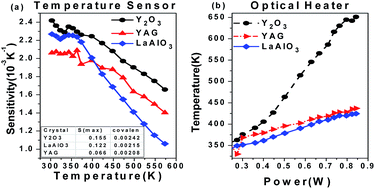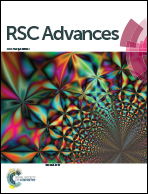Investigation into optical heating and applicability of the thermal sensor bifunctional properties of Yb3+ sensitized Tm3+ doped Y2O3, YAG and LaAlO3 phosphors†
Abstract
Yb3+/Tm3+ doped Y2O3, YAG and LaAlO3 phosphors have been successfully fabricated by the sol–gel method. The phosphors show intense blue emissions under excitation at 980 nm. The possible upconversion (UC) mechanisms have been proposed based on the power-dependence of the UC luminescence (UCL) intensities. The Stark levels (1G4(2)/1G4(1)) of Tm3+ are used to determine the temperature sensing performance by analyzing the temperature dependent UCL spectra from 303 to 573 K. The intensity ratio of the 1G4(2) → 3H6 and 1G4(1) → 3H6 transitions has been found to increase with the increase in laser pump power, which can be used to estimate the internal temperature of materials. Furthermore, the sensor sensitivities of the samples have been calculated and the factors affecting the sensitivity are discussed in detail through chemical bond theory. All the experimental results indicate that the blue emissions from the phosphors may be used for photothermal ablation (PTA) therapy and fluorescent bio-labels.


 Please wait while we load your content...
Please wait while we load your content...